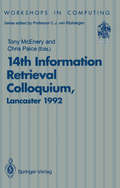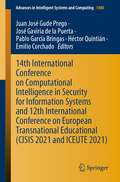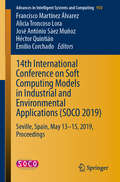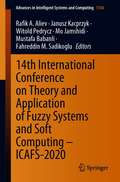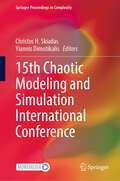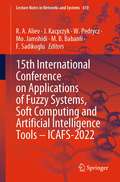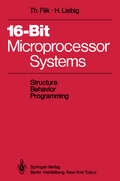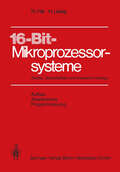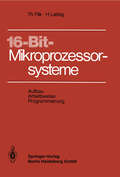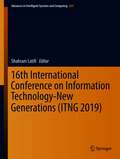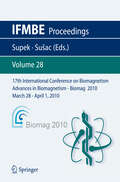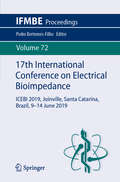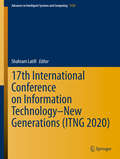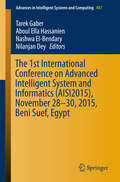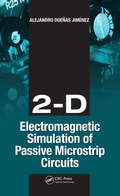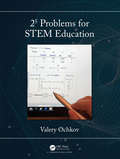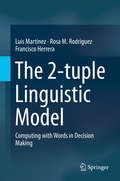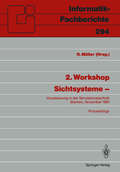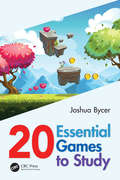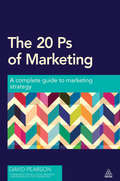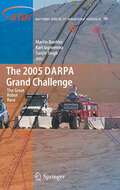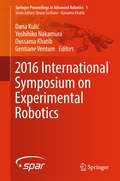- Table View
- List View
14th Information Retrieval Colloquium: Proceedings of the BCS 14th Information Retrieval Colloquium, University of Lancaster, 13-14 April 1992 (Workshops in Computing)
by Anthony McEnery Chris PaiceWe hope that all readers will find the papers included in this volume of interest. All were presented at the 14th BCS IRSG Research Colloquium held at Lancaster University on 13th-14th April 1992. The papers display very well the scope and breadth of information retrieval, as indeed did the workshop ilself. They also present a good cross-section of current IR research, and as such provide a useful signpost for trends in information retrieval. Before we finish we must thank the following colleagues: Simon Botley, Paul Rayson and Paul Jones for their help in the organization of the conference. We would also like to extend a special message of thanks to Professor G.N. Leech of the Department of Linguistics at Lancaster and Roger Garside of the Department of Computing at Lancaster for their support during the conference period. Tony McEnery would also like to express his thanks and gratitude to Paul Baker for his help during the production of this book. September 1992 Tony McEnery Chris Paice Contents A Logical Model of Information Retrieval Based on Situation Theory M. La/mas and K. van Rijsbergen ........................................................ .
14th International Conference on Computational Intelligence in Security for Information Systems and 12th International Conference on European Transnational Educational (Advances in Intelligent Systems and Computing #1400)
by Héctor Quintián Emilio Corchado Pablo García Bringas Juan José Gude Prego José Gaviria de la PuertaThis book of Advances in Intelligent and Soft Computing contains accepted papers presented at CISIS 2021 and ICEUTE 2021, all conferences held in the beautiful and historic city of Bilbao (Spain), in September 2021.The aim of the 14th CISIS 20121 conference is to offer a meeting opportunity for academic and industry-related researchers belonging to the various, vast communities of computational intelligence, information security, and data mining. The need for intelligent, flexible behavior by large, complex systems, especially in mission-critical domains, is intended to be the catalyst and the aggregation stimulus for the overall event.After a through peer-review process, the CISIS 2021 International Program Committee selected 23 papers which are published in these conference proceedings achieving an acceptance rate of 40%. In this relevant edition, a special emphasis was put on the organization of special sessions. One special session is organized related to relevant topics as follows: building trust in ecosystems and ecosystem components.In the case of 12th ICEUTE 2021, the International Program Committee selected 17 papers, which are published in these conference proceedings. One special session is organized related to relevant topics as follows: sustainable personal goals: engaging students in their learning process.The selection of papers is extremely rigorous in order to maintain the high quality of the conference, and we would like to thank the members of the program committees for their hard work in the reviewing process. This is a crucial process to the creation of a high standard conference, and the CISIS and ICEUTE conferences would not exist without their help.
14th International Conference on Soft Computing Models in Industrial and Environmental Applications: Seville, Spain, May 13–15, 2019, Proceedings (Advances in Intelligent Systems and Computing #950)
by Francisco Martínez Álvarez Alicia Troncoso Lora José António Sáez Muñoz Héctor Quintián Emilio CorchadoThis book includes 57 papers presented at the SOCO 2019 conference held in the historic city of Seville (Spain), in May 2019. Soft computing represents a set of computational techniques in machine learning, computer science and various engineering disciplines, which investigate, simulate, and analyze very complex issues and phenomena. The selection of papers was extremely rigorous in order to maintain the high quality of the conference, which featured a number of special sessions, including sessions on: Soft Computing Methods in Manufacturing and Management Systems; Soft Computing Applications in the Field of Industrial and Environmental Enterprises; Optimization, Modeling and Control by Soft Computing Techniques; and Soft Computing in Aerospace, Mechanical and Civil Engineering: New methods and Industrial Applications.
14th International Conference on Theory and Application of Fuzzy Systems and Soft Computing – ICAFS-2020 (Advances in Intelligent Systems and Computing #1306)
by Rafik A. Aliev Janusz Kacprzyk Witold Pedrycz Mo Jamshidi Mustafa Babanli Fahreddin M. SadikogluThis book presents the proceedings of the 14th International Conference on Applications of Fuzzy Systems, Soft Computing, and Artificial Intelligence Tools, ICAFS-2020, held in Budva, Montenegro, on August 27–28, 2020. It includes contributions from diverse areas of fuzzy systems, soft computing, AI tools such as uncertain computation, decision making under imperfect information, deep learning and others. The topics of the papers include theory and application of soft computing, neuro-fuzzy technology, intelligent control, deep learning–machine learning, fuzzy logic in data analytics, evolutionary computing, fuzzy logic and artificial intelligence in engineering, social sciences, business, economics, material sciences and others.
15th Chaotic Modeling and Simulation International Conference (Springer Proceedings in Complexity)
by Christos H. Skiadas Yiannis DimotikalisThis proceedings of 15th CHAOS2022 International Conference highlights recent developments in nonlinear, dynamical, and complex systems. The conference was intended to provide an essential forum for Scientists and Engineers to exchange ideas, methods, and techniques in the field of Nonlinear Dynamics, Chaos, Fractals and their applications in General Science and Engineering Sciences. The principal aim of CHAOS2022 International Conference is to expand the development of the theories of the applied nonlinear field, the methods, empirical data and computer techniques as well as the best theoretical achievements of chaotic theory. CHAOS2022 Conference provides a forum for bringing together the various groups working in the area of Nonlinear and Dynamical Systems, Chaotic theory and Application to exchange views and report research findings.
15th International Conference on Applications of Fuzzy Systems, Soft Computing and Artificial Intelligence Tools – ICAFS-2022 (Lecture Notes in Networks and Systems #610)
by R. A. Aliev J. Kacprzyk W. Pedrycz Mo. Jamshidi M. B. Babanli F. SadikogluThe general scope of the book covers diverse areas of fuzzy systems, soft computing, AI tools such as uncertain computation, decision-making under imperfect information, deep learning, and others. The topics of the papers include theory and application of Soft Computing, Neuro-Fuzzy Technology, Intelligent Control, Deep Learning-Machine Learning, Fuzzy Logic in Data Analytics, Evolutionary Computing, Fuzzy logic and Artificial Intelligence in Engineering, Social Sciences, Business, Economics, Material Sciences, and others.This book presents the proceedings of the 16th International Conference on Applications of Fuzzy Systems, Soft Computing, and Artificial Intelligence Tools, ICAFS-2022, held in Budva, Montenegro, on August 26-27, 2022. This is a useful guide for academics, practitioners, and graduates in fields of fuzzy logic and soft computing. It allows for increasing of interest in development and applying of these paradigms in various real-life fields.
16-Bit-Microprocessor Systems: Structure, Behavior, and Programming
by Thomas Flik Hans LiebigIn the last few years, a large number of books on microprocessors have appeared on the market. Most of them originated in the context of the 4-bit and the 8-bit microprocessors and their comparatively simple structure. However, the techno-logical development from 8-bit to 16-bit microprossors led to processor components with a substantially more complex structure and with an expanded functionality and also to an increase in the system architecture's complexity. This books takes this advancement into account. It examines 16-bit micro-processor systems and descrihes their structure, their behavior and their programming. The principles of computer or ganization are treated at the component level. This is done by means of a detailed examination of the characteristic functionali ty of microprocessors. Furthermore the interactions between hardware and software, that are typical of microprocessor technology, are introduced. Interfacing techniques are one of the focal points of these considerations. This puplication is organized as a textbook and is intended as a self-teaching course on 16-bit microprocessors for students of computer science and communications, design engineers and users in a wide variety of technical and scientific fields. Basic knowledge of boolean algebra is assumed. The choice of material is based on the 16-bit microprocessors that are currently available on the market; on the other hand, the presentation is not bound to anyone of these microprocessors.
16th International Conference on Information Technology-New Generations (Advances in Intelligent Systems and Computing #800)
by Shahram LatifiThis 16th International Conference on Information Technology - New Generations (ITNG), continues an annual event focusing on state of the art technologies pertaining to digital information and communications. The applications of advanced information technology to such domains as astronomy, biology, education, geosciences, security and health care are among topics of relevance to ITNG. Visionary ideas, theoretical and experimental results, as well as prototypes, designs, and tools that help the information readily flow to the user are of special interest. Machine Learning, Robotics, High Performance Computing, and Innovative Methods of Computing are examples of related topics. The conference features keynote speakers, the best student award, poster award, service award, a technical open panel, and workshops/exhibits from industry, government and academia.
17th International Conference on Biomagnetism Advances in Biomagnetism - Biomag 2010 - March 28 - April 1, 2010: Biomag March 28 - April 1, 2010 (IFMBE Proceedings #28)
by Selma Supek Ana Susac40th anniversary of "medical uses of SQUID" th It is my great pleasure and honor to invite you to the 17 International Conference on Biomagnetism – Biomag2010 held in Dubrovnik, Croatia from Sunday, March 28 through Thursday, April 1, 2010. The interdisciplinary field of biomagnetism includes dynamic and evolving SQUID-based technologies offering advanced real-time methods for noninvasive assessments of magnetic signals from the brain, heart and other organs as well as a range of modeling, mathematical and computational methods for functional source localization approaches. Excellent spatial resolution and unique, millisecond, temporal resolution of biomagnetic techniques allow insights into cortical neurodynamics and neurobiological basis of the human brain as well as assessment of heart and other organs functions in health and disease. Biomag2010 will be a great opportunity for an exchange of ideas and presentation of the latest developments in instrumentation, modeling approaches, basic and clinical biomedical studies. We are particularly proud to announce the celebration of the 40th anniversary of the first SQUID-based MCG measurements published on April 1, 1970. Since then ''medical uses of SQUID'' were dynamic and growing, including the most recent developments, in combination with a low field MRI, toward a ''direct neuronal imaging''. Dubrovnik, the host city of the Biomag2010, a jewel on the Adriatic, will be a superb and stimulating setting for both scientific and social aspects of this meeting. I am looking forward to hosting you in Dubrovnik, Croatia in spring of 2010.
17th International Conference on Electrical Bioimpedance: ICEBI 2019, Joinville, Santa Catarina, Brazil, 9-14 June 2019 (IFMBE Proceedings #72)
by Pedro Bertemes-FilhoThis book gathers the proceedings of the 17th International Conference on Electrical Bioimpedance (ICEBI 2019), held on June 9-14, in Joinville, Santa Catarina, Brazil. The chapters cover the latest knowledge and developments concerning: sensors and instrumentation to measure bioimpendance, bioimpedance imaging techniques, theory and modeling and bioimpendance, as well as cutting-edge clinical applications of bioimpendance. All in all, this book provides graduate students and researchers with an extensive and timely snapshot of current research and challenges in the field of electrical bioimpendance, and a source of inspiration for future research and cross-disciplinary collaborations.
17th International Conference on Information Technology–New Generations (Advances in Intelligent Systems and Computing #1134)
by Shahram LatifiThis volume presents the 17th International Conference on Information Technology—New Generations (ITNG), and chronicles an annual event on state of the art technologies for digital information and communications. The application of advanced information technology to such domains as astronomy, biology, education, geosciences, security, and healthcare are among the themes explored by the ITNG proceedings. Visionary ideas, theoretical and experimental results, as well as prototypes, designs, and tools that help information flow to end users are of special interest. Specific topics include Machine Learning, Robotics, High Performance Computing, and Innovative Methods of Computing. The conference features keynote speakers; a best student contribution award, poster award, and service award; a technical open panel, and workshops/exhibits from industry, government, and academia.
The 1st International Conference on Advanced Intelligent System and Informatics (Advances in Intelligent Systems and Computing #407)
by Tarek Gaber Aboul Ella Hassanien Nashwa El-Bendary Nilanjan DeyThe conference topics address different theoretical and practical aspects, and implementing solutions for intelligent systems and informatics disciplines including bioinformatics, computer science, medical informatics, biology, social studies, as well as robotics research. The conference also discuss and present solutions to the cloud computing and big data mining which are considered hot research topics. The conference papers discussed different topics – techniques, models, methods, architectures, as well as multi aspect, domain-specific, and new solutions for the above disciplines. The accepted papers have been grouped into five parts:Part I—Intelligent Systems and Informatics, addressing topics including, but not limited to, medical application, predicting student performance, action classification, and detection of dead stained microscopic cells, optical character recognition, plant identification, rehabilitation of disabled people.Part II—Hybrid Intelligent Systems, addressing topics including, but not limited to, EMG signals, text classification, geomagnetic inverse problem, email filtering.Part III—Multimedia Computing and Social Networks, addressing topics including, but not limited to, augmented reality, telepresence robot, video flash matting, community detection, quality images, face thermal image extraction, MRI tumor segmentation.Part V—Cloud Computing and Big Data Mining, discussing topics including, but not limited to, mining on microblogs, query optimization, big data classification, access control, friendsourcing, and assistive technology.Part VI—Swarm Optimization and Its Applications, addressing topics including, but not limited to, solving set covering problem, adaptive PSO for CT liver segmentation, water quality assessment, attribute reduction, fish detection, solving manufacturing cell design problem.
2-D Electromagnetic Simulation of Passive Microstrip Circuits
by Alejandro D. JimenezGlobal Demand for Streamlined Design and Computation The explosion of wireless communications has generated a tidal wave of interest and development in computational techniques for electromagnetic simulation as well as the design and analysis of RF and microwave circuits. Learn About Emerging Disciplines, State-of-the-Art Methods2-D Electromagnetic Simulation of Passive Microstrip Circuits describes this simple procedure in order to provide basic knowledge and practical insight into quotidian problems of microstrip passive circuits applied to microwave systems and digital technologies. The text dissects the latest emerging disciplines and methods of microwave circuit analysis, carefully balancing theory and state-of-the-art experimental concepts to elucidate the process of analyzing high-speed circuits. The author covers the newer techniques – such as the study of signal integrity within circuits, and the use of field map interpretations – employed in powerful electromagnetic simulation analysis methods. But why and how does the intrinsic two-dimensional simulation model used here reduce numerical error? Step-by-Step Simulation Provides Insight and UnderstandingThe author presents the FDTD electromagnetic simulation method, used to reproduce different microstrip test circuits, as well as an explanation of the complementary electrostatic method of moments (MoM). Each reproduces different microstrip test circuits that are physically constructed and then studied, using a natural methodological progression to facilitate understanding. This approach gives readers a solid comprehension and insight into the theory and practical applications of the microstrip scenario, with emphasis on high-speed interconnection elements.
2-D Electromagnetic Simulation of Passive Microstrip Circuits
by Alejandro D. JimenezGlobal Demand for Streamlined Design and Computation The explosion of wireless communications has generated a tidal wave of interest and development in computational techniques for electromagnetic simulation as well as the design and analysis of RF and microwave circuits. Learn About Emerging Disciplines, State-of-the-Art Methods2-D Electromagnetic Simulation of Passive Microstrip Circuits describes this simple procedure in order to provide basic knowledge and practical insight into quotidian problems of microstrip passive circuits applied to microwave systems and digital technologies. The text dissects the latest emerging disciplines and methods of microwave circuit analysis, carefully balancing theory and state-of-the-art experimental concepts to elucidate the process of analyzing high-speed circuits. The author covers the newer techniques – such as the study of signal integrity within circuits, and the use of field map interpretations – employed in powerful electromagnetic simulation analysis methods. But why and how does the intrinsic two-dimensional simulation model used here reduce numerical error? Step-by-Step Simulation Provides Insight and UnderstandingThe author presents the FDTD electromagnetic simulation method, used to reproduce different microstrip test circuits, as well as an explanation of the complementary electrostatic method of moments (MoM). Each reproduces different microstrip test circuits that are physically constructed and then studied, using a natural methodological progression to facilitate understanding. This approach gives readers a solid comprehension and insight into the theory and practical applications of the microstrip scenario, with emphasis on high-speed interconnection elements.
2⁵ Problems for STEM Education
by Valery Ochkov25 Problems for STEM Education introduces a new and emerging course for undergraduate STEM programs called Physical-Mathematical Informatics. This course corresponds with the new direction in education called STE(A)M (Science, Technology, Engineering, [Art] and Mathematics). The book focuses on undergraduate university students (and high school students), as well as the teachers of mathematics, physics, chemistry and other disciplines such as the humanities. This book is suitable for readers who have a basic understanding of mathematics and math software. Features Contains 32 interesting problems (studies) and new and unique methods of solving these physical and mathematical problems using a computer as well as new methods of teaching mathematics and physics Suitable for students in advanced high school courses and undergraduates, as well as for students studying Mathematical Education at the Master’s or PhD level One of the only books that attempts to bring together ST(E)AM techniques, computational mathematics and informatics in a single, unified format
2⁵ Problems for STEM Education
by Valery Ochkov25 Problems for STEM Education introduces a new and emerging course for undergraduate STEM programs called Physical-Mathematical Informatics. This course corresponds with the new direction in education called STE(A)M (Science, Technology, Engineering, [Art] and Mathematics). The book focuses on undergraduate university students (and high school students), as well as the teachers of mathematics, physics, chemistry and other disciplines such as the humanities. This book is suitable for readers who have a basic understanding of mathematics and math software. Features Contains 32 interesting problems (studies) and new and unique methods of solving these physical and mathematical problems using a computer as well as new methods of teaching mathematics and physics Suitable for students in advanced high school courses and undergraduates, as well as for students studying Mathematical Education at the Master’s or PhD level One of the only books that attempts to bring together ST(E)AM techniques, computational mathematics and informatics in a single, unified format
The 2-tuple Linguistic Model: Computing with Words in Decision Making
by Luis Martínez Rosa M. Rodriguez Francisco HerreraThis book examines one of the more common and wide-spread methodologies to deal with uncertainty in real-world decision making problems, the computing with words paradigm, and the fuzzy linguistic approach. The 2-tuple linguistic model is the most popular methodology for computing with words (CWW), because it improves the accuracy of the linguistic computations and keeps the interpretability of the results. The authors provide a thorough review of the specialized literature in CWW and highlight the rapid growth and applicability of the 2-tuple linguistic model. They explore the foundations and methodologies for CWW in complex frameworks and extensions. The book introduces the software FLINTSTONES that provides tools for solving linguistic decision problems based on the 2-tuple linguistic model. Professionals and researchers working in the field of classification or fuzzy sets and systems will find The 2-tuple Linguistic Model: Computing with Words in Decision Making a valuable resource. Undergraduate and postdoctoral students studying computer science and statistics will also find this book a useful study guide.
2. Workshop Sichtsysteme —: Visualisierung in der Simulationstechnik Bremen, 18./19. November 1991 (Informatik-Fachberichte #294)
by Reinhard MöllerProceedings
20 Essential Games to Study
by Joshua BycerThe purpose of this book is to look over the past 35 years of games to discuss titles whose design deserves to be studied by anyone with an interest in game design. While there are plenty of books that focus on the technical side of Game Development, there are few that study the nature of game design itself. Featuring a mix of console and PC offerings, I purposely left off some of the easy choices (Mario, Starcraft, Call of Duty, Overwatch) to focus on games that stood out thanks to their designs. Key Features An informative breakdown focusing on the design and gameplay of successful games Written to be useful for students or designers starting out in game development Books focused specifically on design are rare Perfect for students and professionals alike, or can be read for the nostalgia and history
20 Essential Games to Study
by Joshua BycerThe purpose of this book is to look over the past 35 years of games to discuss titles whose design deserves to be studied by anyone with an interest in game design. While there are plenty of books that focus on the technical side of Game Development, there are few that study the nature of game design itself. Featuring a mix of console and PC offerings, I purposely left off some of the easy choices (Mario, Starcraft, Call of Duty, Overwatch) to focus on games that stood out thanks to their designs. Key Features An informative breakdown focusing on the design and gameplay of successful games Written to be useful for students or designers starting out in game development Books focused specifically on design are rare Perfect for students and professionals alike, or can be read for the nostalgia and history
The 20 Ps of Marketing: A Complete Guide to Marketing Strategy
by David PearsonMarketing has changed dramatically since the four classic Ps of the marketing mix (price, product, promotion and place) were proposed. The new marketing landscape is characterized by the demand for constant innovation, rising pressure on budgets, the growth of social media and the impact of issues of sustainability and ethics. As the business landscape has transformed so have the fundamental areas marketers need to master to succeed.The 20 Ps of Marketing provides a thorough guide to marketers at all levels of the new elements of the marketing mix they need to contend with for business success including: planning; persuasion; publicity; positioning; productivity; partnerships; passion and more. Combining practical advice with case studies it covers brands that have changed the game through mastery of the 20 Ps such as Häagen-Dazs and Sony, and others, such as Kodak, who got left behind.This essential guide to the current face of marketing strategy provides marketers with a thorough and valuable grounding to the new fundamentals of marketing.
The 2005 DARPA Grand Challenge: The Great Robot Race (Springer Tracts in Advanced Robotics #36)
by Martin Buehler Karl Iagnemma Sanjiv SinghThe DARPA Grand Challenge was a landmark in the field of robotics: a race by autonomous vehicles through 132 miles of rough Nevada terrain. It showcased exciting and unprecedented capabilities in robotic perception, navigation, and control. The event took place in October 2005 and drew teams of competitors from academia and industry, as well as many garage hobbyists. This book presents fifteen technical papers that describe each team's driverless vehicle, race strategy, and insights. As a whole, they present the state of the art in autonomous vehicle technology and offer a glimpse of future technology for tomorrow’s driverless cars.
2016 International Symposium on Experimental Robotics (Springer Proceedings in Advanced Robotics #1)
by Dana Kulić Yoshihiko Nakamura Oussama Khatib Gentiane VentureExperimental Robotics XV is the collection of papers presented at the International Symposium on Experimental Robotics, Roppongi, Tokyo, Japan on October 3-6, 2016. 73 scientific papers were selected and presented after peer review. The papers span a broad range of sub-fields in robotics including aerial robots, mobile robots, actuation, grasping, manipulation, planning and control and human-robot interaction, but shared cutting-edge approaches and paradigms to experimental robotics. The readers will find a breadth of new directions of experimental robotics. The International Symposium on Experimental Robotics is a series of bi-annual symposia sponsored by the International Foundation of Robotics Research, whose goal is to provide a forum dedicated to experimental robotics research. Robotics has been widening its scientific scope, deepening its methodologies and expanding its applications. However, the significance of experiments remains and will remain at the center of the discipline. The ISER gatherings are a venue where scientists can gather and talk about robotics based on this central tenet.
